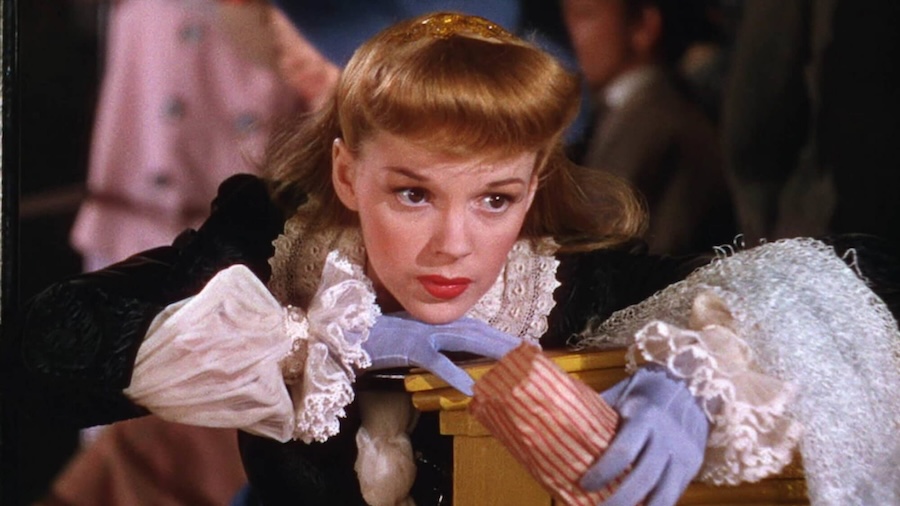
A CAST OF FAVORITES IN THE CHARMING… ROMANTIC… TUNEFUL LOVE STORY OF THE EARLY 1900S!

There was drama behind the scenes of Meet Me in St. Louis, one of the best-loved nostalgia pieces of the early 1940s. Judy Garland reportedly found the script hard to take seriously. Once again, the 21-year-old had been cast as a teenager. Co-star Mary Astor didn’t think she had reason to complain; after all, she didn’t behave like an adult. At the same time, Garland as a former fellow child actor was worried about Margaret O’Brien being worked too hard. It was also the project that introduced Garland to a future husband, director Vincente Minnelli. None of this drama is however evident onscreen; the sweetness is intact.
Romances are brewing
St. Louis, 1903. The city is about to host the Louisiana Purchase Exposition and we are introduced to a comfortable upper middle-class family, the Smiths. Alonzo and Anna (Leon Ames, Astor) have four daughters and a son. The oldest daughters, Rose and Esther (Lucille Bremer, Garland), have romances brewing; Rose is expecting a call from a suitor who may want to propose to her, and Esther is falling in love with the boy next door, John Truett (Tom Drake). However, both love affairs are complicated by various circumstances, the latter because of John’s lacking social skills and an incident during Halloween involving the Smiths’ youngest daughter, Tootie (O’Brien).
The greatest obstacle to happiness for the family though may be Alonzo’s announcement that he’s agreed to a new position in New York City and that they’re all leaving St. Louis…
Simple and nostalgic
Episodic in nature, the film was based on several stories by Sally Benson that were originally published in The New Yorker. The simple, nostalgic and sentimental aspects must have appealed to a public in need of escape from the horrors of World War II; Minnelli’s adaptation certainly did its best to recreate an era that seemed happier and more carefree. It could be argued that the filmmakers went a little too far. Meet Me in St. Louis was the second biggest hit of the year, after the equally upbeat, sweet Going My Way, and many critics still consider it a masterpiece. Many of its ingredients are lovely, for sure. Its sense of humor is quite effective, especially in scenes where Ames is trying to gain control over his unruly family. The film has enthusiastic performances, especially by Garland and young O’Brien who has a lot more on her plate besides looking adorable; she gets to sing and dance, and has a few darker scenes, all of which she handles with great skill.
When there’s no singing and the story is allowed to develop, the lack of anything relevant or exciting becomes a problem.
The musical numbers are highlights, with “The Trolley Song” and “Have Yourself a Merry Little Christmas” as standouts; the latter is performed with a sincerity and melancholy by Garland that instantly set the tone for how this future standard should be sung. Still, when there’s no singing and the story is allowed to develop, the lack of anything relevant or exciting becomes a problem.
The much talked-about exposition does not take place until the end of the film. Even though cinematographer George Folsey created a beautiful illustration of Benson’s memoirs, I can’t help but think that there should be more to this story than simple turn-of-the-century teenage worries.
Meet Me in St. Louis 1944-U.S. 113 min. Color. Directed by Vincente Minnelli. Screenplay: Irving Brecher, Fred F. Finklehoffe. Story: Sally Benson. Cinematography George Folsey. Music: George Stoll. Songs: “The Boy Next Door”, “The Trolley Song”, “Have Yourself a Merry Little Christmas” (Hugh Martin, Ralph Blane). Cast: Judy Garland (Esther Smith), Margaret O’Brien (“Tootie” Smith), Lucille Bremer (Rose Smith), Tom Drake, Mary Astor, Leon Ames, June Lockhart, Harry Davenport.
Trivia: Van Johnson was originally cast as John Truett. Later a Broadway musical. The film was remade for TV in 1959 and 1966. O’Brien won a special Oscar for her performance in this movie.
Last word: “I had worked on a script, four or five scripts, that Freed didn’t care about. My friend and I started working on a love story. After a while my friend had to leave, so I finished it. Unlike most producers that I had worked with, Freed was very difficult as far as I was concerned. Arthur Freed was a giant son of a… and one of the best producers that MGM ever had. He had a great talent for hiring musical people, songwriters, etc. He was not happy with the St. Louis script. He said, ‘There is NO story.’ They suddenly had a start date. Now in 1944 I think there were two or maybe three Technicolor cameras in Hollywood. They were very much in demand. Before we made the movie is when the real trouble started. The old man (Louis B. Mayer), a man I liked by the way, he was a tyrant, but not with me. They said, ‘The old man can’t do anything with Judy.’ She didn’t want to make the movie. She thought Tootie (Margaret O’Brien) would steal it.” (Brecher, Film Radar)
